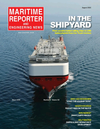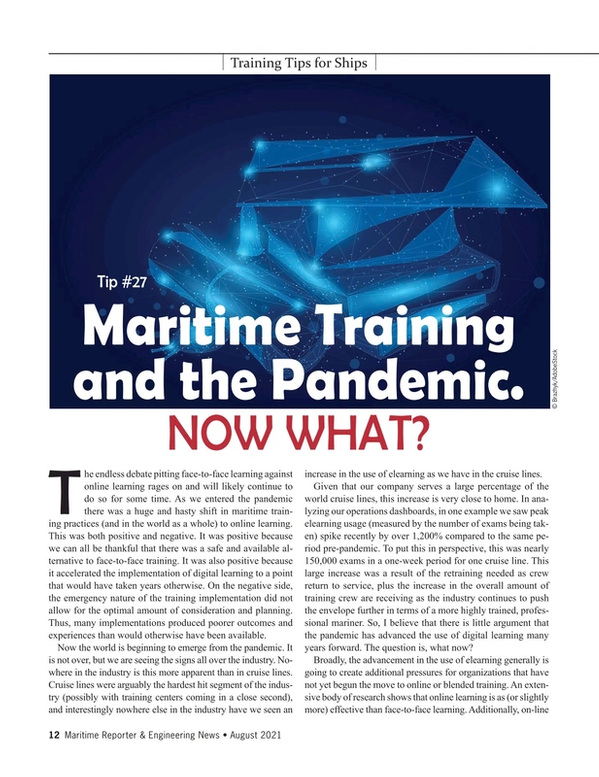
Training Tips for Ships - Tip #27: Maritime Training and the Pandemic. What Now?
The endless debate pitting face-to-face learning against online learning rages on and will likely continue to do so for some time.
As we entered the pandemic there was a huge and hasty shift in maritime training practices (and in the world as a whole) to online learning. This was both positive and negative. It was positive because we can all be thankful that there was a safe and available alternative to face-to-face training. It was also positive because it accelerated the implementation of digital learning to a point that would have taken years otherwise. On the negative side, the emergency nature of the training implementation did not allow for the optimal amount of consideration and planning. Thus, many implementations produced poorer outcomes and experiences than would otherwise have been available.
Now the world is beginning to emerge from the pandemic. It is not over, but we are seeing the signs all over the industry. Nowhere in the industry is this more apparent than in cruise lines. Cruise lines were arguably the hardest hit segment of the industry (possibly with training centers coming in a close second), and interestingly nowhere else in the industry have we seen an increase in the use of elearning as we have in the cruise lines.
Given that our company serves a large percentage of the world cruise lines, this increase is very close to home. In analyzing our operations dashboards, in one example we saw peak elearning usage (measured by the number of exams being taken) spike recently by over 1,200% compared to the same period pre-pandemic. To put this in perspective, this was nearly 150,000 exams in a one-week period for one cruise line. This large increase was a result of the retraining needed as crew return to service, plus the increase in the overall amount of training crew are receiving as the industry continues to push the envelope further in terms of a more highly trained, professional mariner. So, I believe that there is little argument that the pandemic has advanced the use of digital learning many years forward. The question is, what now?
Broadly, the advancement in the use of elearning generally is going to create additional pressures for organizations that have not yet begun the move to online or blended training. An extensive body of research shows that online learning is as (or slightly more) effective than face-to-face learning. Additionally, on-line learning tends to be more “trainee-friendly”. Trainees can learn whenever they want, and wherever they want. The digital experience also conforms more to individual learning styles than does in-class training. If instead of online learning we consider blended learning, where in-person training is combined with on-line learning, the effect is even more strongly positive. In the blended case, learning outcomes are significantly better than face-to-face or on-line outcomes, as is learner satisfaction. For training centers, vessel owners and regulators, on-line learning also produces a deeper set of records and learning analytics that can be mined for audit purposes and continuous improvement. This, together with the pandemic-induced accelerated movement to on-line learning, means that organizations are going to face increased pressure from their employees and ultimately even regulators to digitize.
So, for many maritime training organizations it will soon be a time to take a step back, assess and consolidate. What training has been implemented on-line in response to the pandemic? How does its quality and organization stand up to the standards of a post pandemic world where “urgent” can’t be an excuse for “barely acceptable”? In most cases the core of quality will have been created to be used as a starting point. From that starting point, we can plan what needs to be done to improve the content, presentation and program. What do we need to survey or measure to understand what is going well and what needs to be improved?
The pandemic has forced us, in many cases, to take the first big step. Let’s use what we’ve done as an organizational asset and begin the cycle of continuous improvement that was unavailable to us in the heat of the pandemic battle. The world has changed, in some ways for the better.
Until next time, sail safely.
Read Training Tips for Ships - Tip #27: Maritime Training and the Pandemic. What Now? in Pdf, Flash or Html5 edition of August 2021 Maritime Reporter
Other stories from August 2021 issue
Content
- Training Tips for Ships - Tip #27: Maritime Training and the Pandemic. What Now? page: 12
- U.S. Navy Asserts “Freedom of Navigation” in the South China Sea page: 16
- What We Have Here is a Failure to Communicate…. in Ship Construction! page: 16
- UECC’s Edvardsen on Decarbonization: “There is no perfect solution, start the journey now” page: 21
- Shipbuilding: International WTIV Market Represents a $14B Opportunity page: 30
- Workforce Development: Apprenticeship Programs Help Build the Fleet page: 34
- Inside The Apprentice School at Newport News Shipbuilding with Dr. Latitia McCane page: 38
- Video Interview: Dominicana Caribbean Shipyards Opens page: 40
- Tech in Focus: Elastomeric Repair and Protective Coatings page: 52


